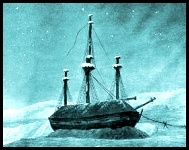
 Hunker Down for Winter When a large sailing ship became ice-bound in the Arctic (as happened with Franklin, Parry and others), the crew had to prepare it for the winter. 1. Much of the rigging was taken down and carried ashore. Loaded with ice, it could break or tip the ship. 2. A storehouse was often built onshore. Equipment and supplies were taken off to both make more room for the men and lighten the ship - the higher the waterline, the less likely to be crushed by ice. 3. To add extra insulation, the decks were covered with a thick layer of packed snow and a wall of snow was built around the hull. 4. Canvas tents were raised over the deck to give the men a place to exercise. 5. Rows of posts were sunk in the ice to show a path to shore in winter darkness or storms. 6. Fire holes were cut in the ice (and kept clear all winter) so that water would be available in case of fire. PICTURE: The ice-bound Parry Expedition - winter of 1820.
Click pictures for more information and credits. Library: Arctic, Boats/Ships/Subs Exploration, Explorers Franklin Expedition Links: Arctic, Boats & Ships Northwest Passage, Franklin Expedition Arctic Maps & Weather Reports Guide to Arctic Sunrise & Sunset |

|
DICTIONARY: Just "double-click" any unlinked word on this page for the definition from Merriam-Webster's Student Electronic Dictionary at Word Central. |

|
ARCTIC LIBRARY & GLOSSARY: Check this section for an index of the rest of the things you really need to know about the Arctic. |

|
ARCTIC MAPS & WEATHER REPORTS: Maps of the Northwest Passage, explorers' routes, iceberg sources, Nunavut, the Arctic by treeline, temperature... |

|
ARCTIC LINKS: Even more information! Links to sites related to the Arctic and "Iceberg: the Story of the Throps and the Squallhoots". |

|
GUIDE TO ARCTIC SUNRISE & SUNSET: How much sunlight or darkness is there in the Arctic on each day of the year? |
to is the property of their respective owners, and Athropolis is not responsible for their content.